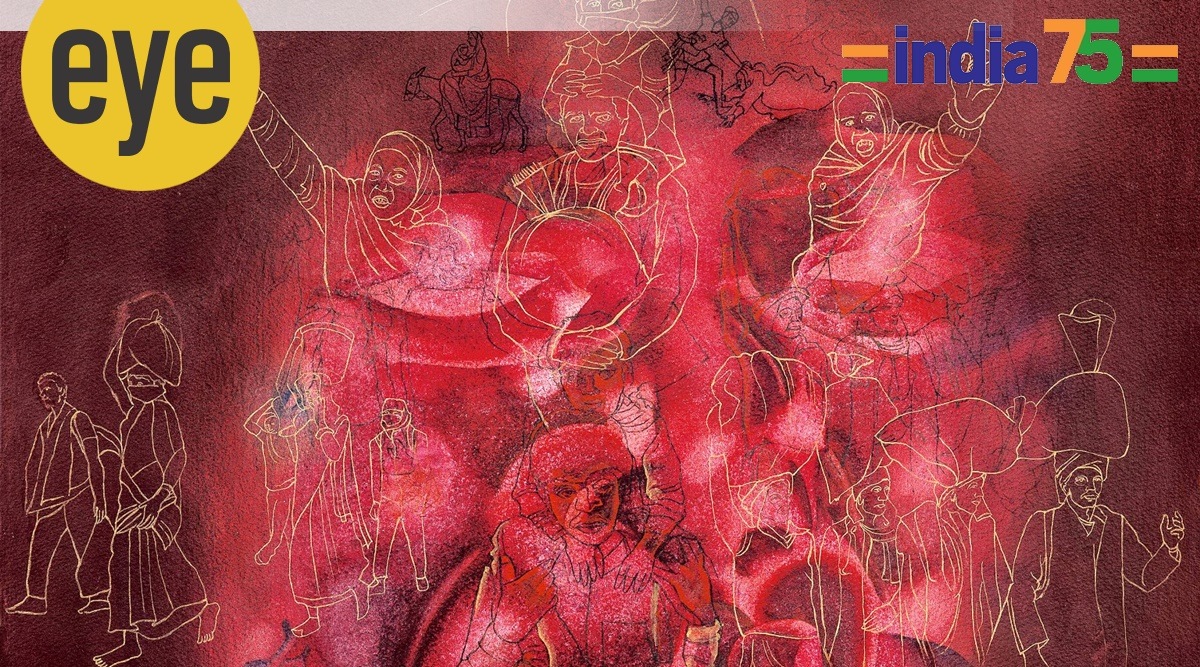 Shoulder to shoulder
Gulammohammed Sheikh’s watercolour on arches paper, Undying Erasures (2021)
Courtesy: Vadehra Art Gallery
Shoulder to shoulder
Gulammohammed Sheikh’s watercolour on arches paper, Undying Erasures (2021)
Courtesy: Vadehra Art Gallery Almost simultaneously at two ends of the country, two events defined the quest for the new nation’s cultural identity. One is the formation of the Progressive Artists’ Group in the metropolitan city of Bombay in 1947, which heralded the arrival of the “modern” on the horizon of contemporary art in India. The collective brought together a motley group of artists (a Catholic from Goa, a Bohra from Indore, two Maharashtrian Hindus, a Dalit and a Kashmiri) on a platform that effaced regional or religious identities with an unfettered spirit of art. Each with an individual vision, these artists from diverse backgrounds were charged by their staunch resistance to colonial modes and narrow parochialism. The group emulated the international modern as a model to surge ahead with a passion for initiating a new era of vital and vigorous art.
The second instance took place in a small hamlet of Santiniketan between the end of 1946 and the beginning of 1947. Benode Behari Mukherjee, an artist with an epic vision despite his poor eyesight, vividly envisaged the lives of medieval saints in a mural spanning 88 feet. The tall figures of Ramanuja, Kabir, Tulsidas, Surdas and Guru Gobind Singh, rising from the teeming crowds of an earthy humanity, seem to metaphorise their physical personae into spiritual presences. These freshly-conceived images present an unconventional yet somewhat universal vision of sainthood. The vast fresco seems to address the emergent nation to listen to the stories of its soul enshrined in its past simultaneously with attending to the call of its present. Painted in sober tones of earth colours, it invokes distilled aspects of the traditional, yet pulsates with the spirit of the modern.
In both instances, modernity was viewed in a dialogue between the past and the present. Such an objective has come to partial fruition in the three-quarters of a century the nation has passed through. The dialogue was attempted with the building of art institutions in the form of the akademis, art colleges, museums, art galleries, multi-art complexes, an international triennale, and, finally, a world-class biennale, each full of adventurous strides. Some of these institutions grew, others crumbled, degenerated or collapsed with political interference or because of their internal failings. However, a vibrant, if somewhat small (and gradually expanding) community of four to five generations of artists emerged and has survived with or without institutional support, developing a unique camaraderie across generations.
Initially focussed upon painting and sculpture, and then slowly branching out into murals and public sculptures, art practice brought photography in its fold and broke the boundaries of still and moving images with video. It finally embraced multiple forms with site-specific installations. The disciplines of art are not confined to physical objects alone; digital explorations or art discourses and the realm of ideas form part of the larger art spectrum. From a humble beginning, contemporary Indian art has made deeper inroads into world-art arenas over the years, especially in the last four decades. What is of cardinal importance is the rise of a sizeable number of women artists. Art practices have moved from studio interiors to a wider arena, addressing political, social or historical issues with a critical eye. Whether with narrative confessionals, feminist protests against patriarchy, expressions of queer identities or exposés of environmental depredations, artists have stood their ground defending freedom of expression.
I had turned 10 when Independence dawned. Around that time, in my small town of Surendranagar in the erstwhile Saurashtra state, an event took place that has remained etched in my mind. Whether it was a dispute between teachers and administration, I do not remember, but the whole school with teachers and hundreds of students left the premises of a private English-medium school to move into a Gujarati-medium school. Having grown up in a Gujarati-speaking home, I was delighted to find myself being able to read every textbook. Independence gave me the chance to fuel my hunger for reading and boost my love of writing poetry at a very young age. The school also provided room for my urge to paint.
Despite the stories of Partition doing the rounds, my middle-class Kathiawadi Muslim family did not dream of leaving the home and hearth they had lived in for generations. Nor did they object to my scribbles and drawings. While in high school, I joined the visiting artist Ravishankar Rawal to paint the external walls of the local library with shadow images (chhaya-chitra) of world history in earth colours.
Little did I know that 50 years later I would be making world maps again, this time in digital format. Ravibhai, as he was known, encouraged me to study art in Baroda (at the MS University), where I learnt from some of the pioneers ofIndian modernism. The individuals and institutions in Baroda changed the course of my life and gave me a life-long vocation. We learnt to bring the past, present and other cultures in dialogue with our own experiences, evolving individual voices and collective solidarities. Thousands of such tales have made up the story of art in our nation.
Gulammohammed Sheikh, 84, is an artist, poet and critic, based in Vadodara
- The Indian Express website has been rated GREEN for its credibility and trustworthiness by Newsguard, a global service that rates news sources for their journalistic standards.

